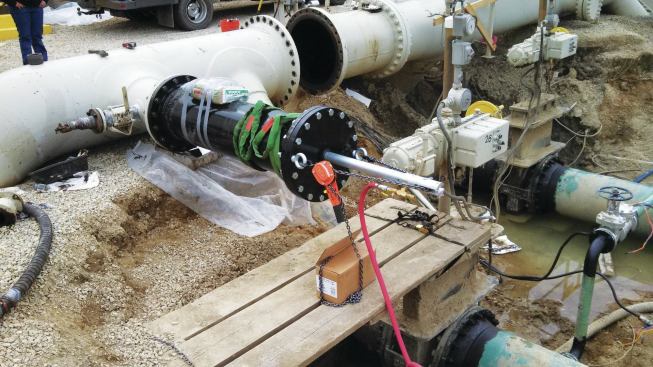Petersen Products
Preparing end of pipe for connection downstream of inflatable li…
How to intentionally stop a sewer
Inflatable plugs are more commonly used in the small-diameter, high-pressure pipes of industrial plants and refineries, but are proving to be equally useful in large-diameter sewers, waterlines, and other municipal applications. Finding a contractor that specializes in the latter applications, however, is a tall order, which is why Hollywood’s Public Utilities self-performs plug installations.
Such initiative is emblematic of the award-winning enterprise operation. The city’s drinking water has won American Water Works Association Best Tasting Drinking Water and earned EPA Consumer Confidence Report Excellence awards. The department produces 7 billion gallons annually.
The department’s 39.1 mgd Category II, Class A activated sludge wastewater treatment plant includes a reclamation facility that provides water that irrigates many of the city’s golf courses.
The department turned to its supplier on previous inflatable-plug projects: Petersen Products Co. in Fredonia, Wis. Founded in 1916, the company makes inflatable and mechanical plugs, grout and relining packers, sewer and drain flushers, and lift cylinders and bags for pipeline and wastewater applications such as high-pressure gas lines, large tunnels, and mine dewatering operations.
Petersen uses the client’s specifications to produce each inflatable plug individually. For Hollywood, ballistic nylon reinforced with an external layer of ethylene propylene diene monomer (EDPM, a type of synthetic rubber) was customized with dual inflation/deflation ports to accommodate inflation with water or grout or, if higher pressures were needed, air. All related pumps, valves, regulators, and monitors were custom-matched to the plug and provided by Petersen. The complete package was delivered about two weeks after Hollywood’s order.
The bag was 17 inches in diameter, allowing for insertion through a manhole. Inflated, it’s more than 12 feet long. About 8 feet of that was in direct contact with the pipe, providing the seal.
“Even deflated, it’s a big, bulky thing,” says operations supervisor William Feliciano. “We moved it into place with a crane. At the end of the project, we pulled it out with a backhoe, and the backhoe tipped up a bit.”
Plugs are sometimes test-inflated outside the pipe at low pressure to check dimensions and confirm diameter and length. But in this case, “We were concerned that without the constraints of the pipe, a bag this size would distort or stretch,” Bolton says.
After pumping out some of the water, crews inserted the plug 1,000 feet upstream of the treatment plant using a cable and winch. Initial inflation was with water.
“You have to fill with water first to get a good seal and make sure the plug holds where you want it to be,” Feliciano explains. “Water’s heavy, though, and can stretch out the plug if it’s in place for a long time.”
So after inflation with water, crews placed conversion attachments at the dual inflation/deflation ports and used a small, portable air compressor to pump air into the plug, gradually displacing the water. Air pressure was raised to 12 psi and monitored continually.
Next page: Five-month gamble pays off









